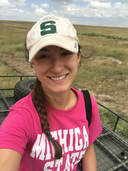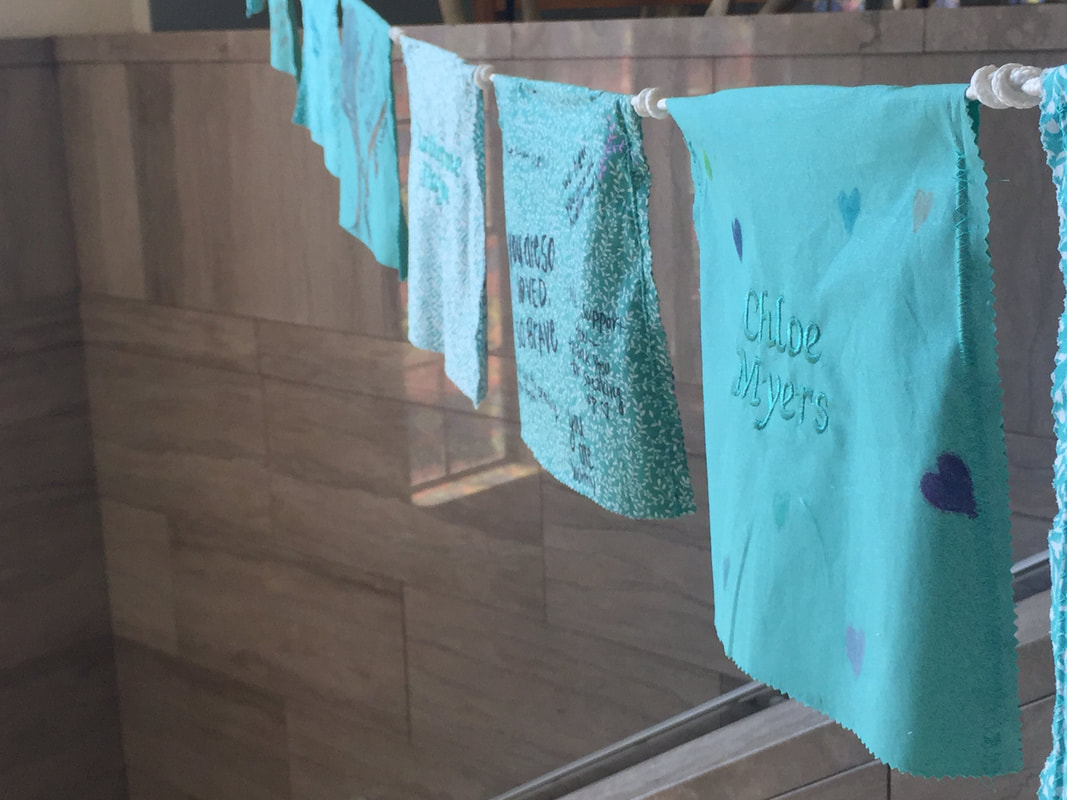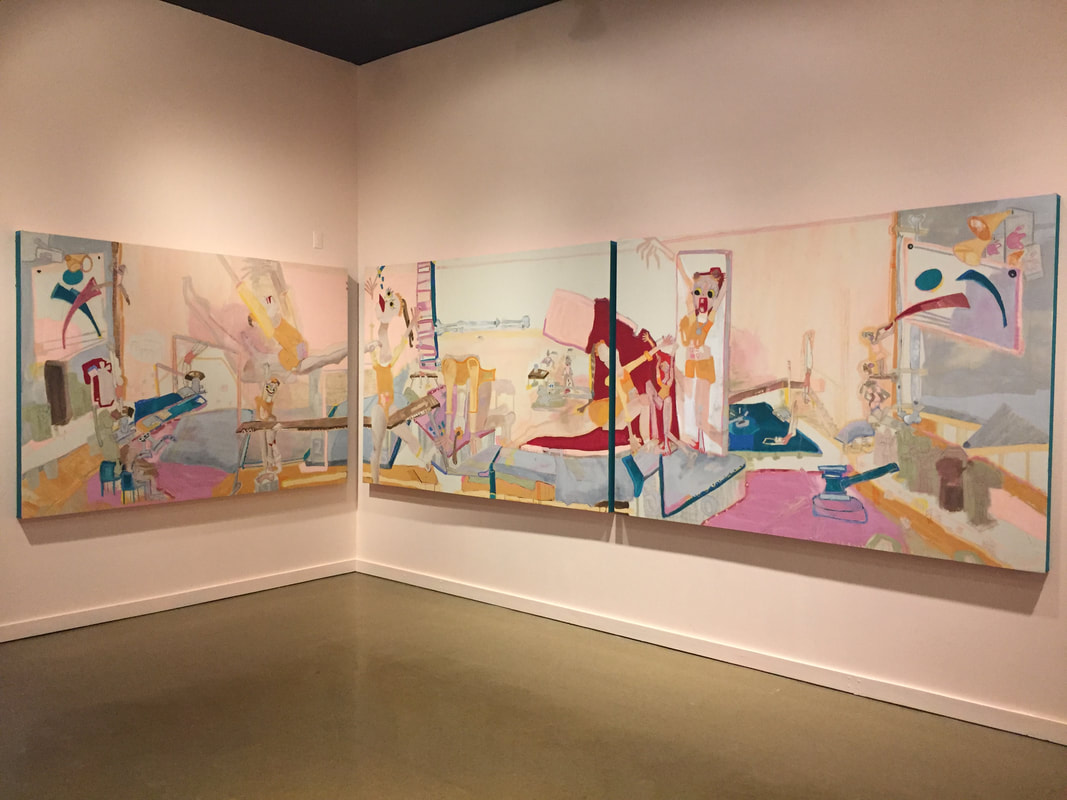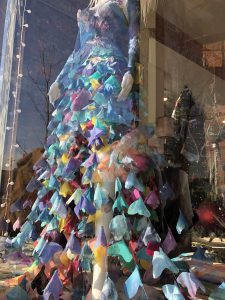|
4/12/2019 0 Comments Sister Survivors of Sexual Abuse at Michigan State University Tell Their Story Through Groundbreaking Museum ExhibitBy Olivia Spagnuolo Walking across Michigan State University (MSU) campus in spring of 2018, students bore witness to 221 teal bows adorning trees and the bridge between the Hannah Administration Building and Wells Hall. Looking closer at each bow, one could notice a small ribbon bearing the name or case number of a sister survivor of the monstrous, decades-long sexual abuse perpetrated by Larry Nassar, a former trusted physician for MSU and USA Gymnastics. These bows withstood snow, sun, and rain, serving as a reminder of the suffering and resiliency of the survivors. Over the past year, this quiet gesture has grown into a ground-breaking, controversial, and powerful exhibit at the MSU Museum, entitled, “Finding Our Voice: Sister Survivors Speak.” The sister survivors are refusing to be silenced any longer, and the world is finally listening. The Metamorphosis of the Tribute The teal bows were one of the early steps taken by survivors toward transforming MSU campus – the scene of the crime – into a healing space. Teal has emerged as the color of sexual abuse awareness and prevention. These bows stood to remind the community of the trauma endured by the survivors as a result of institutional failures, in the hopes that these lessons would reshape MSU over time. They were also tributes to the strength of the survivors, who visited their trees to pray, meditate, and reflect. However, just months later, the survivors received disheartening news: the bows needed to be removed immediately. Gypsy moths (Lymantria dispar), an invasive species, had begun to lay eggs in the fine netting of the bows. If allowed to hatch, the caterpillars would spend each night feeding and destroying the leaves of the tree. Furthermore, females of this species are flightless and stay on the same tree their entire lives. Therefore, unless disrupted, generations of gypsy moth caterpillars would result in the destruction of numerous trees on campus. Parents of the survivors were horrified to learn that MSU had proposed to remove and burn the teal bows. Survivors and their families wanted to protect the trees, but also felt a close association with the bows. MSU Museum Director Dr. Mark Auslander and the parents of the survivors found a compromise: only mothers of survivors would be allowed to remove the bows. Museum staff would then respectfully bag and display the bows. Staff also recorded the location of each tree and the name or case number of the sister survivor associated with it. This data will be incorporated into an app that will allow survivors to find their tree. The museum was then faced with the question of how to display the ribbons and bows. The staff originally thought of having a small exhibit to display them but, as they spoke with survivors and their parents, they realized there was potential for a major exhibition. Museum staff decided that, if they were going to honor the survivors, it couldn’t just be “an aside;” it needed to be the main exhibit. The next question was how to design the exhibit. Conventionally, experienced museum professionals design the exhibit, but Dr. Auslander decided to go back to the drawing board and completely rethink the approach to design in this case. These young women had lost autonomy over their bodies, and then over their voices, as they were silenced and ignored repeatedly by MSU, the United States Olympics Committee, USA Gymnastics, Twistars, and sometimes even by loved ones. “This exhibit should put them back in the driver’s seat,” said Dr. Auslander. Survivors and their parents thus took on the role of citizen curators, forming the Survivors and Allies Advisory Council. The Council was responsible for every decision involving the exhibit design, from the underlying themes and objects displayed to the lighting of the exhibit itself. They also had support from an exhibit design team (Exhibit Manager Teresa Goforth, Curator of Textiles and Social Justice Mary Worrall, Education Manager Denice Blair, Museum Director Mark Auslander, and Exhibit Designer Kelly Hansen). This bold approach led the Council and the museum staff into uncharted territory; the role of the museum was not to design the exhibit, as Dr. Auslander explained, but “to bring the Council’s vision to light.” Mothers of Sister Survivors Emerge as Citizen Scientists Meanwhile, the teal bows waited in the museum to be processed. These bows are not only culturally valuable, but also contained Gypsy moth eggs, which could be studied to better understand the population of this invasive and destructive insect in Michigan. As time passed, however, the mothers of young women who had been violated on campus felt quite understandably uneasy about the bows – which had come to symbolize their daughters – being processed in an MSU laboratory. Instead, Parents of Sister Survivors Engage (POSSE), originally founded to create hundreds of prayer flags for survivors, stepped up as citizen scientists to process the bows themselves. The MSU Museum designed a workshop, led by experienced textile conservator Jane Hammond, where POSSE members were trained to remove insect material like moth eggs. They were taught how to gently rinse the bows with deionized water so they could do so in their own homes. The bows, whose bright teal colors were restored by the deionized water, were then returned to the museum to be displayed. Exhibit Design: Bringing the Council’s Vision to Light In the months leading up to April, the Survivors and Allies Advisory Council and the exhibit design team worked diligently to bring their vision to light. This exhibit exists not only as a healing space for survivors and their families, but to convey several important messages to the community. First, the exhibit shows the magnitude of the crime: Nassar sexually assaulted over 500 young people who trusted him. Second, the exhibit highlights both individuality and collective action. The survivors are unique, each with their own stories, but this traumatic chapter in their stories unites them. They support one another, which has been critical in healing and making their voice heard. They also express that they were not just passive victims, but survivors of the abuse. The exhibit puts a spotlight on MSU, emphasizing institutional accountability; that is, there was more than one perpetrator in this string of crimes. The university, along with multiple other institutions, failed to protect these people for thirty years. Most importantly, the exhibit is filled with a message of optimism and hope for transformation. The core message is directed toward all survivors – of this crime and others, of all genders and backgrounds – you are not alone. To spell out this message, the exhibit will contain objects of pain and objects of healing. Nassar was an experienced predator who groomed his targets. Sexual predators often groom children for abuse by building trust with the child and their family, making it easier to manipulate and deceive them. Nassar frequently brought the young gymnasts food, drinks, and gifts. These objects of pain appear early in the exhibit. One chilling example is a tiny, brightly colored jacket decorated with gymnasts’ silhouettes; this jacket was presented to an eight-year-old girl, preceding sexual abuse. Another heart-breaking item in this part of the exhibit is a poem written by a girl who was 8 years old when Nassar began sexually abusing her. The second half of the exhibit displays objects of healing. Winter of 2018-2019 was a difficult time for survivors: Nassar’s trial was underway and MSU Interim President John Engler – who has since resigned – spewed one cruel and shameful comment after another regarding the sister survivors. During this time, survivors and their families got together to create items such as the “staffs of strength” (made by survivors) and “bowls of life” (made by parents), which will be displayed alongside the teal bows from the trees. Teal prayer flags, bearing words of support from thousands of MSU students, are displayed in the museum stairwell. POSSE created hundreds of prayer flags to honor sister survivors, a Tibetan tradition meant to spread compassion. Flags bearing the names of sister survivors are hanging together along Grand River, immediately north of campus. Sister Survivors, POSSE members, and East Lansing Mayor Mark Meadows spoke at the Dedication Ceremony, which took place on April 11. The remaining flags, signed by thousands of MSU students with words of support and encouragement, are currently displayed in the MSU Museum stairwell. Other survivors wrote, painted, wove, and built other pieces independently. Art student and sister survivor Jordyn Fishman attended a lecture by Dr. Auslander at the University of Michigan, after which she approached him to introduce herself and describe a triptych (a set of three paintings, representing her stages of internal struggle) that she was painting about her experience as a survivor. Her powerful paintings, “Together We Roar, Part 2” now hangs in the museum. This complex narrative uses many symbolic components to tell a story of recovery from an individual perspective and from the perspective of the larger supportive community of sister survivors, who Fishman includes in her painting. “If it wasn’t for the army of survivors, I wouldn’t have had the strength to make this work. I wouldn’t have had the understanding to make this work,” Fishman explained during an interview with Dr. Apryl Pooley, a neuroscientist at MSU specializing in the effects of sexual trauma on the brain. “I just wanted to say thank you to the army and that this work pays tribute to us.” Jordyn Fishman’s triptych “Together We Roar, Part 2” is now displayed on the second floor of the MSU Museum. Sister survivor Alex Bourque was inspired by American poet Maya Angelou, who wrote, “We admire the beauty of the butterfly but we rarely admit the changes it has gone through to achieve that beauty.” Bourque incorporated hundreds of brightly colored silk butterflies suspended into a dress, entitled “Transformed into Butterflies (Ten Feet Tall)”. This sculpture honors the sister survivors, who have bravely lent their voices to the struggle against sexual violence, as well as Bourque’s family, friends, and coworkers, who have supported her. This piece reinforces the themes of individuality and collective action, as the positive transformation is made of not one, but hundreds of butterflies of different colors and species. Alex Bourque’s sculpture “Transformed into Butterflies (Ten Feet Tall)” will serve as the centerpiece of the exhibit. (Photo credit: Dr. Mark Auslander.) What Makes This Exhibit So Groundbreaking? “Finding Our Voice: Sister Survivors Speak” is revolutionary in many ways. The exhibit was not designed exclusively by museum staff, but in close consultation with survivors and their families who stepped up as citizen scientists and curators to unanimously decide on every aspect of the exhibit. Nassar’s face does not appear anywhere in the exhibit because this story is not about him; it’s about the survivors. This is a bold exhibit; not only does it cover an uncomfortable, controversial, and tremendously sensitive topic, but it shines a light on institutional accountability. “I really appreciate [Dr. Auslander’s] dedication to keeping this story alive,” said MSU student and sister survivor Kat Ebert, who is fighting to bring resources for sexual abuse survivors together under one roof on MSU campus. “If [people] don’t want to talk about it, because it’s uncomfortable, well, it is uncomfortable. If you don’t talk about taboo topics, it’s never going to get better. It’ll never be comfortable.” The exhibit is born at the intersection of science, art, and conservation. The exhibit first began to evolve from the bows that survivors’ mothers removed on campus. Their actions preserved the campus arboretum and enabled the Gypsy moth eggs in the bows to be used for research. The incorporation of butterflies, many of which are of global conservation concern, is emblematic of the transformation undergone by survivors as they pull together as a community to heal. The exhibit particularly emphasizes the neurobiology underlying sexual trauma, for which many neuroscientists on-campus were consulted. One of the museum’s objectives was to create a space for important conversations among women, men, and non-binary people from different fields, particularly scientists. In their interview, Fishman and Dr. Pooley discussed how the 3-dimensional shape of Fishman’s mural reflects that healing is not a linear process, but is cyclical, often without a clear beginning or end. Over the coming year, a speaker session and roundtable discussions will feature various groups of women on-campus from diverse fields. Finally, this exhibit has provided an opportunity for young girls and women who were victimized and silenced by MSU to take their voices back and establish a space for healing on-campus. It has been just a little over a year since the cold early months of 2018 when the teal, netted bows were tied around the trunks of the trees in the arboretum. But this is only the first step in a long journey of transformation, both for survivors of sexual abuse and for MSU as an institution. The onus is on us, as a society, to effect change, following the example of the sister survivors: through individual and collective action. Upcoming Events The exhibit will be open to the public from April 16, 2019 through March 20, 2020. Several events will take place on Tuesday, April 16: 12:00 noon at Beaumont Tower: Carillon Concert and speech by Tana Fedewa, Director of MSU’s Sexual Assault Program 1:00 pm immediately east of MSU Museum: Tree planting ceremony 5:30 pm: MSU Museum first floor: Exhibition opens to public 6:00 pm: MSU Museum second floor: Reception with speeches by sister survivors, Judge Aquilina, MSU Board of Trustees Chairperson Dianne Byrum, and local and state officials Events associated with this exhibit will continue to take place throughout April (Sexual Assault Awareness Month). These events are listed below: Thursday, April 18, 10:00 am-8:00 pm, MSU Museum and MSU Union: Take Back the Night MSU will involve multiple events throughout the day. For more information, click here. Saturday, April 20, 1:00-2:00 pm, MSU Museum: Dr. Auslander will lead attendees of this “Teal Talk” on a tour of the exhibit, discussing the role of museums as healing spaces. Tuesday, April 23, 5:30 pm, MSU Museum: The final panel of the Speaker Series, “Repair: Art, Ceremony, and Healing in the Shadow of Violence,” will take place. Videos of each panel discussion of the Speaker Series are available online here. Tuesday, April 23, 7:15 pm, MSU Museum: “Using our Voices: A Spoken Word Showcase Supporting Survivors” will address sexual violence awareness. Friday, April 26, 12:00-1:00 pm, MSU Museum: Dr. Schattschneider, a psychoanalytic anthropologist, will lead attendees of this “Teal Talk” on a tour of the exhibit, discussing the lessons we’ve learned from this project. For more information, contact Penny Davis from University Communications at (517) 355-5158 (phone) or [email protected] (email).  About the Author Olivia Spagnuolo is a PhD student at MSU, studying large carnivore behavior and conservation in East Africa. She volunteers at Potter Park Zoo, fosters cats and dogs for the humane society, and co-runs Biology on Tap in Lansing, Michigan. In her free time, she practices krav maga, runs, and finds any excuse to pet a dog.
0 Comments
Your comment will be posted after it is approved.
Leave a Reply. |
LIFESTYLE BLOGRead our lifestyle advice, written exclusively for pre-professional women in science and engineering. From advice about fashion, work and family balance, self, wellness, and money, we've got you covered! |
The Scientista Foundation, Inc. All Rights Reserved © 2011-2021 | Based in NY | [email protected]
The Network for Pre-Professional Women in Science and Engineering
The Scientista Foundation is a registered 501(c)(3) -- Donate!
The Network for Pre-Professional Women in Science and Engineering
The Scientista Foundation is a registered 501(c)(3) -- Donate!



